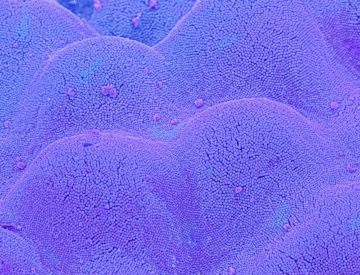Marco Jost in Nature:
 Our main goal is to begin deciphering the molecular communication between bacteria (and the small molecules they secrete) and host cells in the small intestine. We’re particularly interested in enteroendocrine cells — cells found in the lining of the small intestine and throughout the intestinal tract — and how the small-intestine microbiome prompts them to release hormones. We also want to explore how this communication allows gut bacteria to alter physiology throughout the body. We know that gut bacteria affect biological processes in distal places such as the brain and skeletal muscles. I believe that bacterial communication with enteroendocrine cells is a major mechanism. These cells secrete hormones and neurotransmitters, and they also talk to neurons, sending signals across the body. We know there are physical interactions, where bacteria adhere to host cells. There are also chemical-signaling interactions, where intestinal cells sense and react to small molecules produced by microbes. We don’t yet understand the full context or implications of this molecular language in the small intestine. We hope to begin probing which small molecules the enteroendocrine cells respond to, which bacteria produce these molecules, which receptors they bind to, and how that translates to changes in biological processes. Our hope is to provide valuable novel therapeutic targets, not just for metabolic disorders, but also for neuropsychiatric conditions, and disorders influenced by the microbiome.
Our main goal is to begin deciphering the molecular communication between bacteria (and the small molecules they secrete) and host cells in the small intestine. We’re particularly interested in enteroendocrine cells — cells found in the lining of the small intestine and throughout the intestinal tract — and how the small-intestine microbiome prompts them to release hormones. We also want to explore how this communication allows gut bacteria to alter physiology throughout the body. We know that gut bacteria affect biological processes in distal places such as the brain and skeletal muscles. I believe that bacterial communication with enteroendocrine cells is a major mechanism. These cells secrete hormones and neurotransmitters, and they also talk to neurons, sending signals across the body. We know there are physical interactions, where bacteria adhere to host cells. There are also chemical-signaling interactions, where intestinal cells sense and react to small molecules produced by microbes. We don’t yet understand the full context or implications of this molecular language in the small intestine. We hope to begin probing which small molecules the enteroendocrine cells respond to, which bacteria produce these molecules, which receptors they bind to, and how that translates to changes in biological processes. Our hope is to provide valuable novel therapeutic targets, not just for metabolic disorders, but also for neuropsychiatric conditions, and disorders influenced by the microbiome.
What cells and molecules will you focus on?
The small intestine is an incredibly dynamic environment, and we know that diet is a key influence on small-intestine activity. We also know there is a rich diversity of enteroendocrine cells in the small intestine, and that the chemical landscape is very interesting. There are different types of enteroendocrine cells, each with its own specialized function. Most commonly, they each secrete a different hormone in response to external prompts such as diet.
More here.
